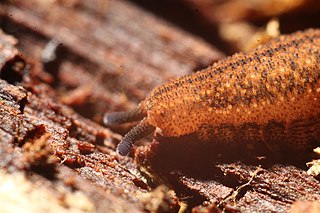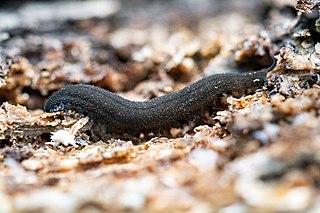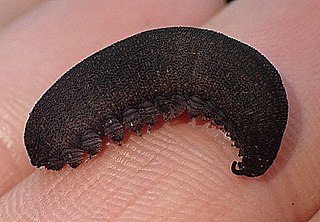Related Research Articles
The pink velvet worm is a species of velvet worm in the Peripatopsidae family. It is known only from Weza Forest, a Mistbelt Forest in South Africa. Opisthopatus roseus has been found on the forest floor amongst leaf litter, beneath, and within fallen logs.

Peripatopsidae is one of the two living velvet worm families.
Cephalofovea is a genus of velvet worms in the Peripatopsidae family. All species in this genus are ovoviviparous and have 15 pairs of oncopods (legs), and both sexes possess a pitted-head which the male everts and uses to pass his spermatophore to the female. They are found in New South Wales, Australia.
Florelliceps is a monospecific genus of ovoviviparous velvet worm containing the single species Florelliceps stutchburyae. This species is brown with 15 pairs of oncopods (legs). During mating, the male of this species uses a structure on his head to place a spermataphore on the gonopore of the female. The type locality is Mount Warning, New South Wales, Australia.
Euperipatoides leuckarti is a species of velvet worm in the family Peripatopsidae. This species is ovoviviparous and has 15 pairs of oncopods (legs). The type locality of this species is Mount Tomah, New South Wales, Australia.
Opisthopatus cinctipes is a species of velvet worm in the Peripatopsidae family. This species has 16 pairs of legs, all with claws and all used for walking. The type locality is in South Africa.
Cephalofovea clandestina is a species of ovoviviparous velvet worm in the family Peripatopsidae. This species has 15 pairs of oncopods (legs) and lives in rotting logs and leaf litter. The type locality is Kanangra-Boyd National Park, New South Wales, Australia. Like all members of the genus Cephalofovea, both sexes of C. clandestina have a furrow on the head, between the antennae, which the male everts to carry his spermatophore to the female.
Cephalofovea pavimenta is a species of velvet worm in the Peripatopsidae family. It is only known from the type locality; Mount Canobolas in New South Wales, Australia.
Cephalofovea tomahmontis is a species of velvet worm in the Peripatopsidae family. This species is ovoviviparous, has 15 pairs of oncopods (legs), and lives in rotting logs and leaf litter. The type locality is Mount Tomah, New South Wales, Australia, after which this species is named. Like all members of the genus Cephalofovea, both sexes of C. tomahmontis have a furrow on the head, between the antennae, which the male everts to carry his spermatophore to the female.

Kumbadjena kaata is a species of velvet worm in the family Peripatopsidae. This species has 15 pairs of legs. The type locality is in Western Australia.
Kumbadjena occidentalis is a species of velvet worm in the family Peripatopsidae described by Joseph James Fletcher in 1895. This species has 15 pairs of legs. The type locality is in Western Australia.
Kumbadjena shannonensis is a species of velvet worm in the Peripatopsidae family. This species has 15 pairs of legs. The type locality is in Western Australia.
Ruhbergia bifalcata is a species of velvet worm in the family Peripatopsidae. The type locality is in New South Wales, Australia.
Ruhbergia brevicorna is a species of velvet worm in the Peripatopsidae family. The type locality is in New South Wales, Australia.
Ruhbergia rostroides is a species of velvet worm in the Peripatopsidae family. The type locality is in New South Wales, Australia.
Paraperipatus papuensis is a species of velvet worm in the Peripatopsidae family. Males in this species have 21 to 27 pairs of legs; females have 21 to 29 leg pairs. The maximum number of leg pairs recorded in this species (29) is also the maximum number of leg pairs found in the family Peripatopsidae. The type locality is in Western New Guinea, Indonesia.
Peripatopsis balfouri is a species of velvet worm in the Peripatopsidae family. This species has 18 pairs of clawed legs. The type locality is in South Africa.
Peripatopsis stelliporata is a species of velvet worm in the Peripatopsidae family. This species has 17 to 19 pairs of legs, usually 18, with the last leg pair reduced more in males than in females. The type locality is in South Africa.

The Overberg velvet worm is a species of velvet worm in the Peripatopsidae family. This species usually has 19 pairs of legs: 18 pregenital leg pairs plus one last pair that is strongly reduced and without claws or spinous pads. Some specimens, however, have only 18 leg pairs. This species is limited to the Overberg region of South Africa.

The Knysna velvet worm is a species of velvet worm in the Peripatopsidae family. This species has 17 pairs of legs with claws, with the last pair of legs reduced. Peripatopsis clavigera is found in subtropical or tropical moist montane forests of South Africa.
References
- ↑ Oliveira I.; Hering L. & Mayer, G. "Updated Onychophora checklist". Onychophora Website. Retrieved 24 November 2016.
- ↑ Reid, A.L.; Tait, N.N.; Briscoe, D.A.; Rowell, D.M. (1995-05-01). "Morphological, cytogenetic and allozymic variation within Cephalofovea (Onychophora: Peripatopsidae) with descriptions of three new species". Zoological Journal of the Linnean Society. 114 (1): 115–138. doi:10.1111/j.1096-3642.1995.tb00116.x. ISSN 0024-4082.
- ↑ Oliveira, I. S.; Read, V. M. S. J.; Mayer, G. (2012). "A world checklist of Onychophora (velvet worms), with notes on nomenclature and status of names". ZooKeys (211): 1–70. doi: 10.3897/zookeys.211.3463 . PMC 3426840 . PMID 22930648.